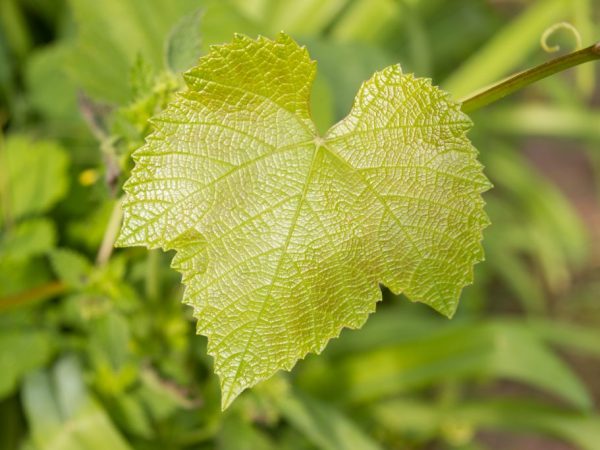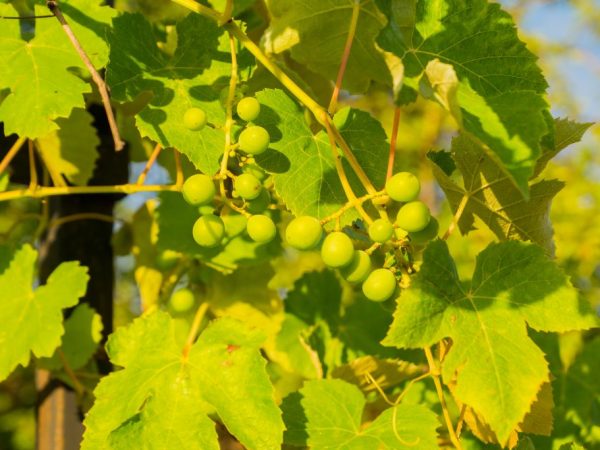Why do grapes have light leaves
Like other berries, grapes are susceptible to diseases that can cause light colored leaves in grapes. Normally, the leaves should be a rich light green or green color.

Why do grapes have light leaves
The reasons for this condition
There are many reasons why grape leaves brighten. Some of them are solved locally, some - in a complex way, by fertilizing and feeding the soil.
Chlorosis
With this disease in grapes, the leaves first turn pale, then turn yellow. The disease affects the plant in a week. There is little chlorophyll in it, the leaves turn yellow due to the inability to process carbon dioxide.
Reasons why young grapes have pale leaves:
- lack of trace elements;
- lack of nitrogen;
- fungal, infectious diseases;
- unfavorable weather conditions.
If a pale grape leaf appears, treatment should be started immediately.
Depending on the reason, the method is chosen: the introduction of compensating substances into the soil or solutions with the necessary substances:
- If chlorosis is carbonate (from excess lime in the soil), add 3 kg of ammonium sulfate to 1 bush.
- If the cause of the disease lies in fungi or infections, prepare a solution of ferrous sulfate (50 g per 10 liters of water), watered at the root.
- The pale and healthy are sprayed with iron chelate solution for 2 weeks. It is prepared by adding 5 g per 10 L of water.
Launched chlorosis is not cured in a month. In case of neglect, the bush weakens immunity, it becomes vulnerable to infectious and viral diseases.
Fungal diseases
Spotted mosaic causes infectious chlorosis. Its carriers are nematodes (the route of infection is through the soil and from other plants).
Signs of illness:
- veins turn yellow;
- yellowness passes to the sheet plate;
- becomes brown, curls and falls off, drying out.
The spotted mosaic is incurable.
It is also dangerous because it spreads to other plants. Affected bushes are uprooted and destroyed, and the soil is disinfected from nematodes.
Light yellow grapes become when affected by the following fungal diseases:
- powdery mildew (powdery mildew);
- downy mildew (mildew).
Infected bushes require special treatment against fungi. During the procedure, put on a respirator and work in change of clothes.

Disease can kill a plant
These solutions are wiped or sprayed on leaf plates from 2 sides. This treatment is carried out several times per season. After a heavy rain, the procedure is repeated. Prescriptions of drugs:
- Lime-sulfuric broth. Take 1 part quicklime, 2 parts sulfur and 17 parts water. Sulfur is mixed with water to a dough state, lime is quenched with water. All are mixed in one container and cooked for an hour. Dilute with water before use.
- The ash solution enriches the soil and helps in the fight against fungi. 1 liter of ash is soaked in 2 liters of water for 3 days. Before use, add 4 liters of water and start processing the bushes. The mixture is poured into the furrows between the berry bushes.
Lack of minerals and trace elements
Compounds of nitrogen, molybdenum, boron, manganese and zinc are considered important for the health of grapes. The lack of these substances makes the plates light green with yellow veins.
In the case of a lack of nitrogen, the leaves of the grapes change color to light green, the petioles become thinner and turn red. Over time, the affected areas die and fall off. In case of a lack of nitrogen, top dressing is applied.
The concentration of the solution depends on the period:
- At the beginning of summer, a concentrated solution of urea is introduced (80 g per 10 l).
- At the end of summer, the concentration is reduced to 15 g per 10 liters.
Zinc is responsible for redox processes. During the lack of an element, green plates cover spots of a metallic shade or a mosaic of the same color.
The problem is solved by introducing foliar solutions of zinc oxide or zinc chelate.
Boron is needed for the reproductive capacity of the plant. Its lack is also reflected in the appearance of the culture: green leaves turn into light, even shine through, brown veins appear. The plant bears poor fruit: ovaries do not appear, shoots weaken. The shortage is made up by foliar baits with boron substances.
Manganese is essential for the berry. It participates in the process of photosynthesis, tissue regeneration, and nutrient absorption. With its lack, green plates become covered with yellow spots, which merge into conglomerates and lead to death. To replenish the substance, foliar treatment with manganese sulfate is carried out.
Prevention of the condition
To avoid pale green areas of the bush, carry out prevention. Avoid feeding the bush and fertilizing the soil with the following substances:
- fresh manure;
- nitric acid compounds of sodium and calcium;
- large doses of superphosphates.
These fertilizers cause an alkaline reaction, which causes the grapes to brighten.
Conclusion
Grape leaves can lighten due to cultural development problems. Light areas appear due to deficiencies in trace elements and minerals, as well as due to infectious diseases and fungi.
Some ailments are incurable, and some require adjustments to the state of the soil or crop health. To prevent pale areas from appearing, it is not recommended to add fresh manure, a large amount of superphosphates and sodium and calcium compounds to the soil.


